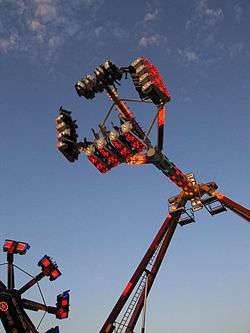Pendulum ride

Pendulum rides are amusement rides based on the motion of a fixed pendulum.[2] The configuration of the ride consists of a gondola, arm, and an axle. One end of the arm is fitted with a passenger-carrying gondola, while the other is attached to the axle. On some models, the arm extends beyond the axle and is fitted with a heavy counterweight. The counterweight is often used when the gondola swings through an inversion. In addition to swinging back and forth, some designs incorporate rotating gondolas and may send riders through a complete inversion. Pendulum rides are propelled by one of two methods: a series of DC motors driving the axle, or wheels at the base of the station pushing the gondola as it swings by.
The pendulum swing ride uses the concept of gravity and centripetal force to operate. (An object traveling in a circular motion has centripetal force- the object accelerates towards the centre of the circle.) The centripetal force acts on the pendulum swing in two different ways; it acts on the main axle, which allows the gondola to swing back and forth. Secondly, the centripetal force acts on the gondola, turning it.
Due to the forces of an object moving in a circle on a vertical plane: at the top of the circle, the force of gravity adds to the tension force coming from the centre of the circle (Fn=Fg+Ft). This makes the rider feel weightless. Similarly, at the bottom of the vertical place, gravity works opposite of tension, making the rider feel extra heavy.
List of rides
Rides that can be considered pendulum rides include:
References
- ↑ http://www.kmg.nl/kmg/factory/freakout_en.html
- ↑ Bruce; Linda Bruce; Sam Bruce; Jack Bruce (2006). Entertainment TechnologyHow does it work?. Black Rabbit Books. p. 28. ISBN 1-58340-792-8.
| Wikimedia Commons has media related to Pendulum rides. |